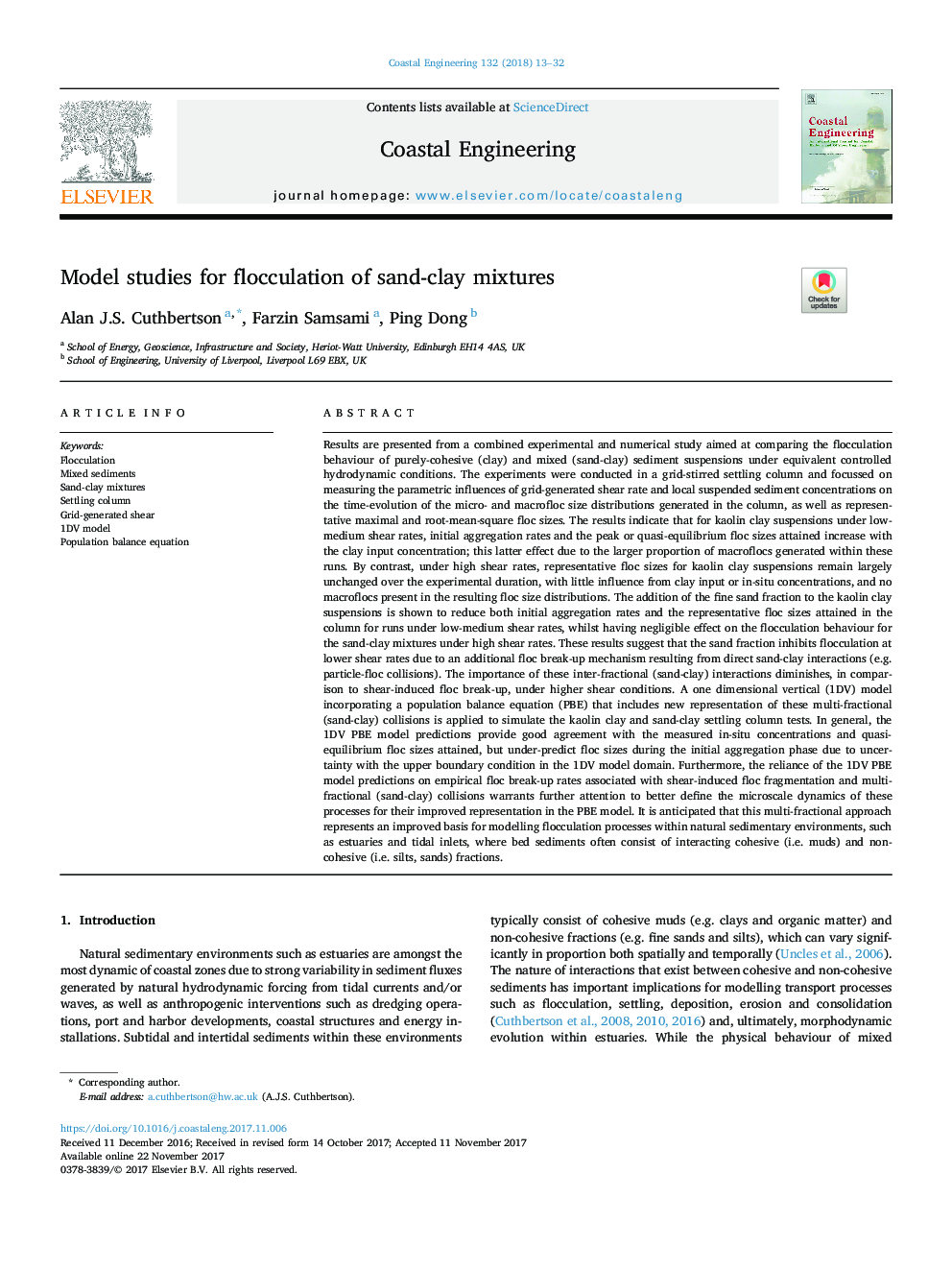| کد مقاله | کد نشریه | سال انتشار | مقاله انگلیسی | نسخه تمام متن |
|---|---|---|---|---|
| 8059580 | 1520322 | 2018 | 20 صفحه PDF | دانلود رایگان |
عنوان انگلیسی مقاله ISI
Model studies for flocculation of sand-clay mixtures
ترجمه فارسی عنوان
مطالعات مدل برای فلکشن مخلوط شن و ماسه
دانلود مقاله + سفارش ترجمه
دانلود مقاله ISI انگلیسی
رایگان برای ایرانیان
کلمات کلیدی
موضوعات مرتبط
مهندسی و علوم پایه
سایر رشته های مهندسی
مهندسی دریا (اقیانوس)
چکیده انگلیسی
Results are presented from a combined experimental and numerical study aimed at comparing the flocculation behaviour of purely-cohesive (clay) and mixed (sand-clay) sediment suspensions under equivalent controlled hydrodynamic conditions. The experiments were conducted in a grid-stirred settling column and focussed on measuring the parametric influences of grid-generated shear rate and local suspended sediment concentrations on the time-evolution of the micro- and macrofloc size distributions generated in the column, as well as representative maximal and root-mean-square floc sizes. The results indicate that for kaolin clay suspensions under low-medium shear rates, initial aggregation rates and the peak or quasi-equilibrium floc sizes attained increase with the clay input concentration; this latter effect due to the larger proportion of macroflocs generated within these runs. By contrast, under high shear rates, representative floc sizes for kaolin clay suspensions remain largely unchanged over the experimental duration, with little influence from clay input or in-situ concentrations, and no macroflocs present in the resulting floc size distributions. The addition of the fine sand fraction to the kaolin clay suspensions is shown to reduce both initial aggregation rates and the representative floc sizes attained in the column for runs under low-medium shear rates, whilst having negligible effect on the flocculation behaviour for the sand-clay mixtures under high shear rates. These results suggest that the sand fraction inhibits flocculation at lower shear rates due to an additional floc break-up mechanism resulting from direct sand-clay interactions (e.g. particle-floc collisions). The importance of these inter-fractional (sand-clay) interactions diminishes, in comparison to shear-induced floc break-up, under higher shear conditions. A one dimensional vertical (1DV) model incorporating a population balance equation (PBE) that includes new representation of these multi-fractional (sand-clay) collisions is applied to simulate the kaolin clay and sand-clay settling column tests. In general, the 1DV PBE model predictions provide good agreement with the measured in-situ concentrations and quasi-equilibrium floc sizes attained, but under-predict floc sizes during the initial aggregation phase due to uncertainty with the upper boundary condition in the 1DV model domain. Furthermore, the reliance of the 1DV PBE model predictions on empirical floc break-up rates associated with shear-induced floc fragmentation and multi-fractional (sand-clay) collisions warrants further attention to better define the microscale dynamics of these processes for their improved representation in the PBE model. It is anticipated that this multi-fractional approach represents an improved basis for modelling flocculation processes within natural sedimentary environments, such as estuaries and tidal inlets, where bed sediments often consist of interacting cohesive (i.e. muds) and non-cohesive (i.e. silts, sands) fractions.
ناشر
Database: Elsevier - ScienceDirect (ساینس دایرکت)
Journal: Coastal Engineering - Volume 132, February 2018, Pages 13-32
Journal: Coastal Engineering - Volume 132, February 2018, Pages 13-32
نویسندگان
Alan J.S. Cuthbertson, Farzin Samsami, Ping Dong,
